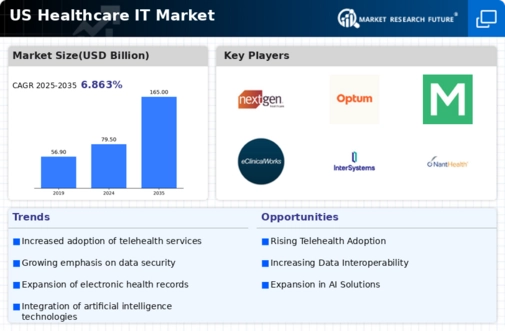Shift Towards Value-Based Care
The transition from fee-for-service to value-based care models is significantly influencing the healthcare it market. This shift emphasizes patient outcomes and cost-effectiveness, compelling healthcare organizations to adopt advanced technologies that facilitate data analytics and performance measurement. It is estimated that by 2026, over 50% of Medicare payments will be tied to value-based care arrangements. Consequently, healthcare providers are increasingly investing in healthcare it solutions that support population health management, care coordination, and patient engagement. This trend not only enhances the quality of care but also aligns with the financial incentives provided by payers. As healthcare organizations adapt to this new paradigm, the demand for innovative healthcare it solutions is likely to surge, driving market growth.
Advancements in Cloud Computing
The healthcare it market is experiencing a transformative phase due to advancements in cloud computing technologies. The adoption of cloud-based solutions is becoming increasingly prevalent among healthcare organizations, as these technologies offer scalability, cost-effectiveness, and enhanced data accessibility. Recent estimates suggest that the cloud computing segment within the healthcare it market could grow at a CAGR of over 20% through 2027. This trend is likely to facilitate the storage and sharing of vast amounts of healthcare data, enabling providers to leverage analytics for improved decision-making. As organizations seek to optimize their operations and reduce IT infrastructure costs, the demand for cloud-based healthcare it solutions is expected to rise, driving market growth.
Growing Demand for Interoperability
The healthcare it market is experiencing a notable shift towards interoperability, driven by the need for seamless data exchange among various healthcare systems. As healthcare providers increasingly recognize the importance of integrated care, the demand for interoperable solutions is expected to rise. According to recent data, approximately 70% of healthcare organizations in the US are prioritizing interoperability initiatives. This trend is likely to enhance patient outcomes and streamline workflows, thereby fostering a more efficient healthcare system. The push for interoperability is also supported by regulatory frameworks that encourage data sharing, which may further propel the growth of the healthcare it market. As a result, vendors that offer robust interoperability solutions are likely to see increased adoption and investment in their technologies.
Increased Focus on Patient Engagement
The healthcare it market is witnessing a heightened emphasis on patient engagement, as healthcare providers recognize the importance of involving patients in their own care. Technologies such as patient portals, mobile health applications, and telehealth services are becoming integral to enhancing patient experience and satisfaction. Recent surveys indicate that nearly 80% of patients prefer to engage with their healthcare providers through digital platforms. This trend is likely to drive the adoption of healthcare it solutions that facilitate communication and empower patients to take an active role in their health management. As healthcare organizations strive to improve patient engagement, the demand for user-friendly and accessible healthcare it tools is expected to grow, further propelling the market.
Regulatory Compliance and Data Management
The healthcare it market is significantly influenced by the need for regulatory compliance and effective data management. With stringent regulations such as HIPAA and HITECH in place, healthcare organizations are compelled to invest in technologies that ensure data security and compliance. It is estimated that compliance-related expenditures account for approximately 15% of total IT budgets in healthcare organizations. This focus on regulatory adherence is likely to drive the demand for healthcare it solutions that offer robust data management capabilities, including electronic health records (EHR) systems and data analytics tools. As organizations navigate the complexities of regulatory requirements, the healthcare it market is expected to expand, with vendors providing innovative solutions to meet compliance needs.



















Leave a Comment